BSBLDR502 Lead & Manage Effective Workplace Relationships Report
VerifiedAdded on 2023/06/10
|17
|4101
|241
Report
AI Summary
This report addresses the critical need for effective workplace relationships, particularly focusing on improving the relationship between a manager and their employees to enhance organizational performance. It presents a comprehensive action plan encompassing nine key tasks, including a detailed communication plan with a timeline, a consultation plan to ensure equal opportunities and measure performance, and a resolution plan for conflict management. The report also emphasizes the importance of diversity and ethics policies to foster a fair and respectful environment. Furthermore, it suggests activities for developing trust among team members and highlights the significance of networking events, role modeling, and professional conduct. Strategies for managing workplace difficulties and a structured process for resolving conflicts are also discussed, aiming to create a harmonious and productive work environment. This document is available on Desklib, a platform offering a wide range of study resources for students.
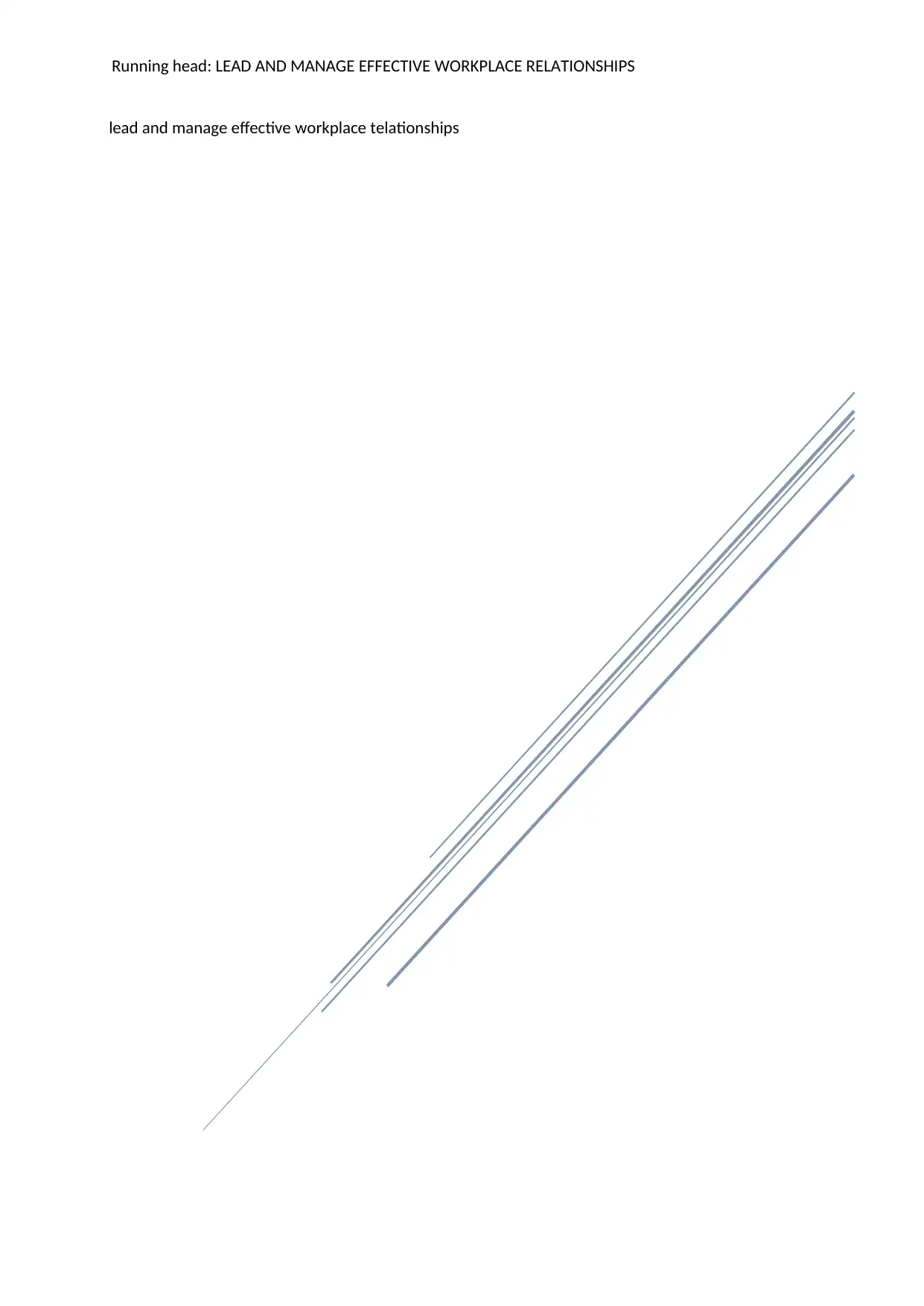
Running head: LEAD AND MANAGE EFFECTIVE WORKPLACE RELATIONSHIPS
lead and manage effective workplace telationships
lead and manage effective workplace telationships
Paraphrase This Document
Need a fresh take? Get an instant paraphrase of this document with our AI Paraphraser
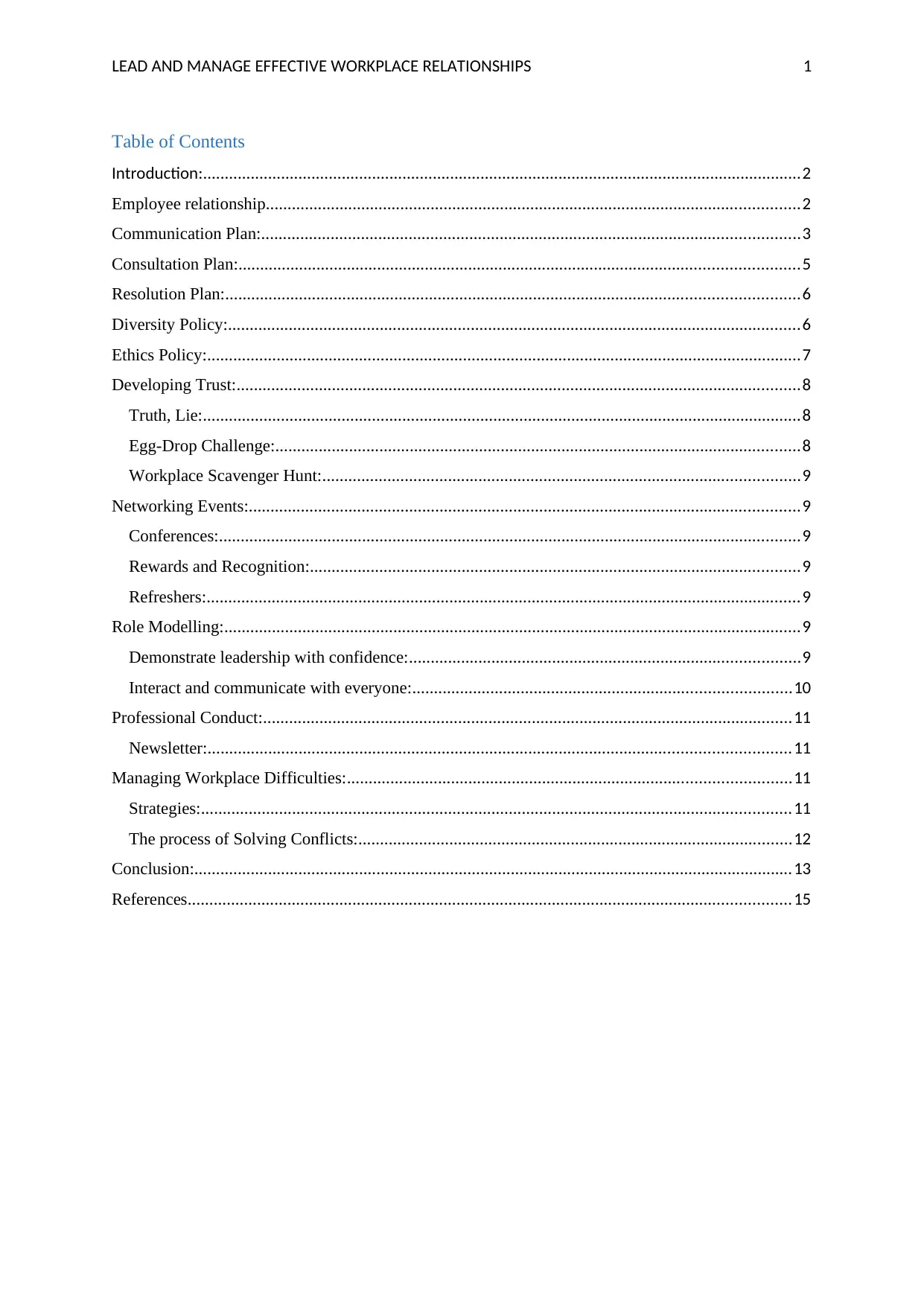
LEAD AND MANAGE EFFECTIVE WORKPLACE RELATIONSHIPS 1
Table of Contents
Introduction:..........................................................................................................................................2
Employee relationship...........................................................................................................................2
Communication Plan:............................................................................................................................3
Consultation Plan:.................................................................................................................................5
Resolution Plan:....................................................................................................................................6
Diversity Policy:....................................................................................................................................6
Ethics Policy:.........................................................................................................................................7
Developing Trust:..................................................................................................................................8
Truth, Lie:..........................................................................................................................................8
Egg-Drop Challenge:.........................................................................................................................8
Workplace Scavenger Hunt:..............................................................................................................9
Networking Events:...............................................................................................................................9
Conferences:......................................................................................................................................9
Rewards and Recognition:.................................................................................................................9
Refreshers:.........................................................................................................................................9
Role Modelling:.....................................................................................................................................9
Demonstrate leadership with confidence:..........................................................................................9
Interact and communicate with everyone:.......................................................................................10
Professional Conduct:..........................................................................................................................11
Newsletter:......................................................................................................................................11
Managing Workplace Difficulties:......................................................................................................11
Strategies:........................................................................................................................................11
The process of Solving Conflicts:....................................................................................................12
Conclusion:..........................................................................................................................................13
References...........................................................................................................................................15
Table of Contents
Introduction:..........................................................................................................................................2
Employee relationship...........................................................................................................................2
Communication Plan:............................................................................................................................3
Consultation Plan:.................................................................................................................................5
Resolution Plan:....................................................................................................................................6
Diversity Policy:....................................................................................................................................6
Ethics Policy:.........................................................................................................................................7
Developing Trust:..................................................................................................................................8
Truth, Lie:..........................................................................................................................................8
Egg-Drop Challenge:.........................................................................................................................8
Workplace Scavenger Hunt:..............................................................................................................9
Networking Events:...............................................................................................................................9
Conferences:......................................................................................................................................9
Rewards and Recognition:.................................................................................................................9
Refreshers:.........................................................................................................................................9
Role Modelling:.....................................................................................................................................9
Demonstrate leadership with confidence:..........................................................................................9
Interact and communicate with everyone:.......................................................................................10
Professional Conduct:..........................................................................................................................11
Newsletter:......................................................................................................................................11
Managing Workplace Difficulties:......................................................................................................11
Strategies:........................................................................................................................................11
The process of Solving Conflicts:....................................................................................................12
Conclusion:..........................................................................................................................................13
References...........................................................................................................................................15
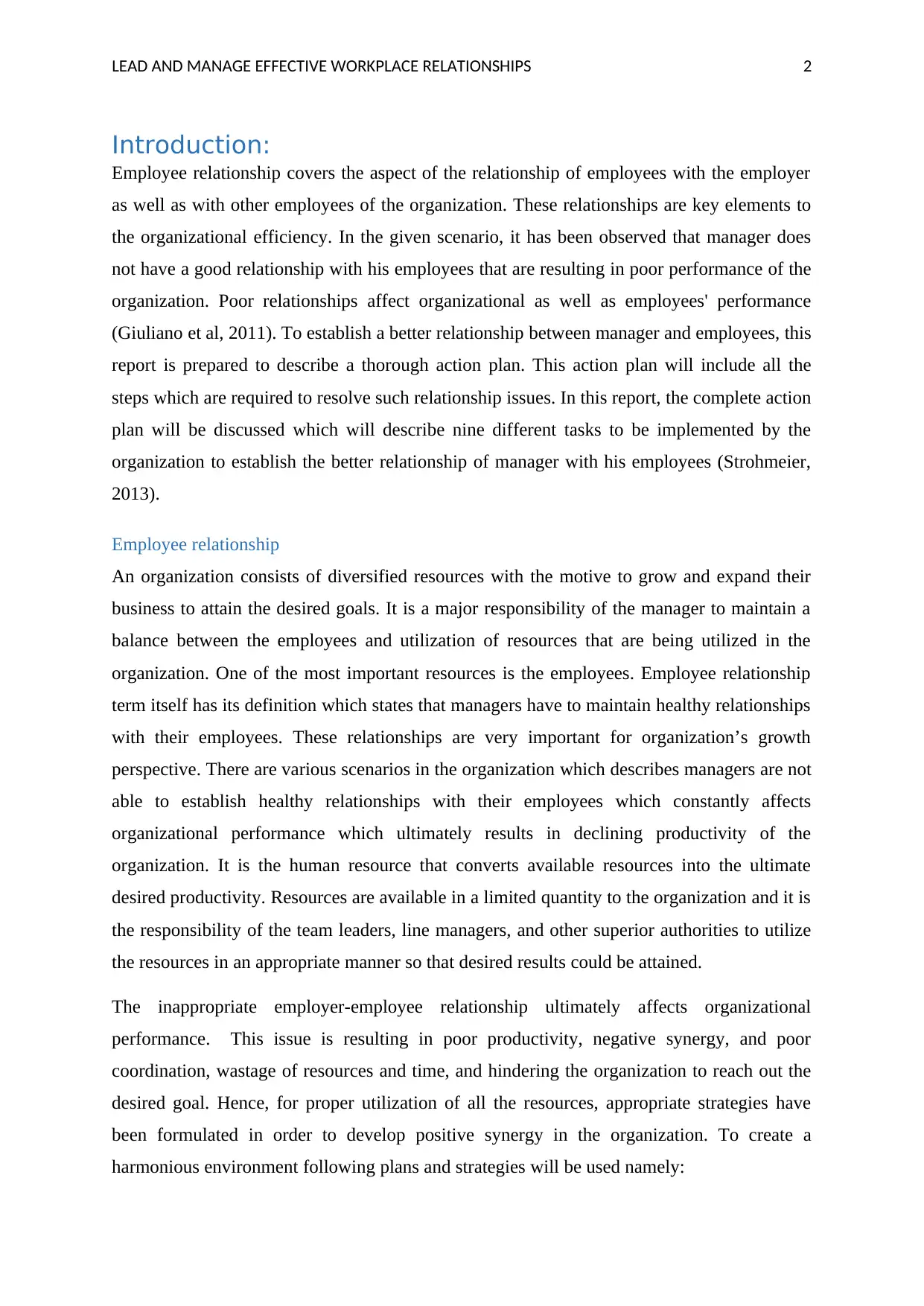
LEAD AND MANAGE EFFECTIVE WORKPLACE RELATIONSHIPS 2
Introduction:
Employee relationship covers the aspect of the relationship of employees with the employer
as well as with other employees of the organization. These relationships are key elements to
the organizational efficiency. In the given scenario, it has been observed that manager does
not have a good relationship with his employees that are resulting in poor performance of the
organization. Poor relationships affect organizational as well as employees' performance
(Giuliano et al, 2011). To establish a better relationship between manager and employees, this
report is prepared to describe a thorough action plan. This action plan will include all the
steps which are required to resolve such relationship issues. In this report, the complete action
plan will be discussed which will describe nine different tasks to be implemented by the
organization to establish the better relationship of manager with his employees (Strohmeier,
2013).
Employee relationship
An organization consists of diversified resources with the motive to grow and expand their
business to attain the desired goals. It is a major responsibility of the manager to maintain a
balance between the employees and utilization of resources that are being utilized in the
organization. One of the most important resources is the employees. Employee relationship
term itself has its definition which states that managers have to maintain healthy relationships
with their employees. These relationships are very important for organization’s growth
perspective. There are various scenarios in the organization which describes managers are not
able to establish healthy relationships with their employees which constantly affects
organizational performance which ultimately results in declining productivity of the
organization. It is the human resource that converts available resources into the ultimate
desired productivity. Resources are available in a limited quantity to the organization and it is
the responsibility of the team leaders, line managers, and other superior authorities to utilize
the resources in an appropriate manner so that desired results could be attained.
The inappropriate employer-employee relationship ultimately affects organizational
performance. This issue is resulting in poor productivity, negative synergy, and poor
coordination, wastage of resources and time, and hindering the organization to reach out the
desired goal. Hence, for proper utilization of all the resources, appropriate strategies have
been formulated in order to develop positive synergy in the organization. To create a
harmonious environment following plans and strategies will be used namely:
Introduction:
Employee relationship covers the aspect of the relationship of employees with the employer
as well as with other employees of the organization. These relationships are key elements to
the organizational efficiency. In the given scenario, it has been observed that manager does
not have a good relationship with his employees that are resulting in poor performance of the
organization. Poor relationships affect organizational as well as employees' performance
(Giuliano et al, 2011). To establish a better relationship between manager and employees, this
report is prepared to describe a thorough action plan. This action plan will include all the
steps which are required to resolve such relationship issues. In this report, the complete action
plan will be discussed which will describe nine different tasks to be implemented by the
organization to establish the better relationship of manager with his employees (Strohmeier,
2013).
Employee relationship
An organization consists of diversified resources with the motive to grow and expand their
business to attain the desired goals. It is a major responsibility of the manager to maintain a
balance between the employees and utilization of resources that are being utilized in the
organization. One of the most important resources is the employees. Employee relationship
term itself has its definition which states that managers have to maintain healthy relationships
with their employees. These relationships are very important for organization’s growth
perspective. There are various scenarios in the organization which describes managers are not
able to establish healthy relationships with their employees which constantly affects
organizational performance which ultimately results in declining productivity of the
organization. It is the human resource that converts available resources into the ultimate
desired productivity. Resources are available in a limited quantity to the organization and it is
the responsibility of the team leaders, line managers, and other superior authorities to utilize
the resources in an appropriate manner so that desired results could be attained.
The inappropriate employer-employee relationship ultimately affects organizational
performance. This issue is resulting in poor productivity, negative synergy, and poor
coordination, wastage of resources and time, and hindering the organization to reach out the
desired goal. Hence, for proper utilization of all the resources, appropriate strategies have
been formulated in order to develop positive synergy in the organization. To create a
harmonious environment following plans and strategies will be used namely:
⊘ This is a preview!⊘
Do you want full access?
Subscribe today to unlock all pages.

Trusted by 1+ million students worldwide
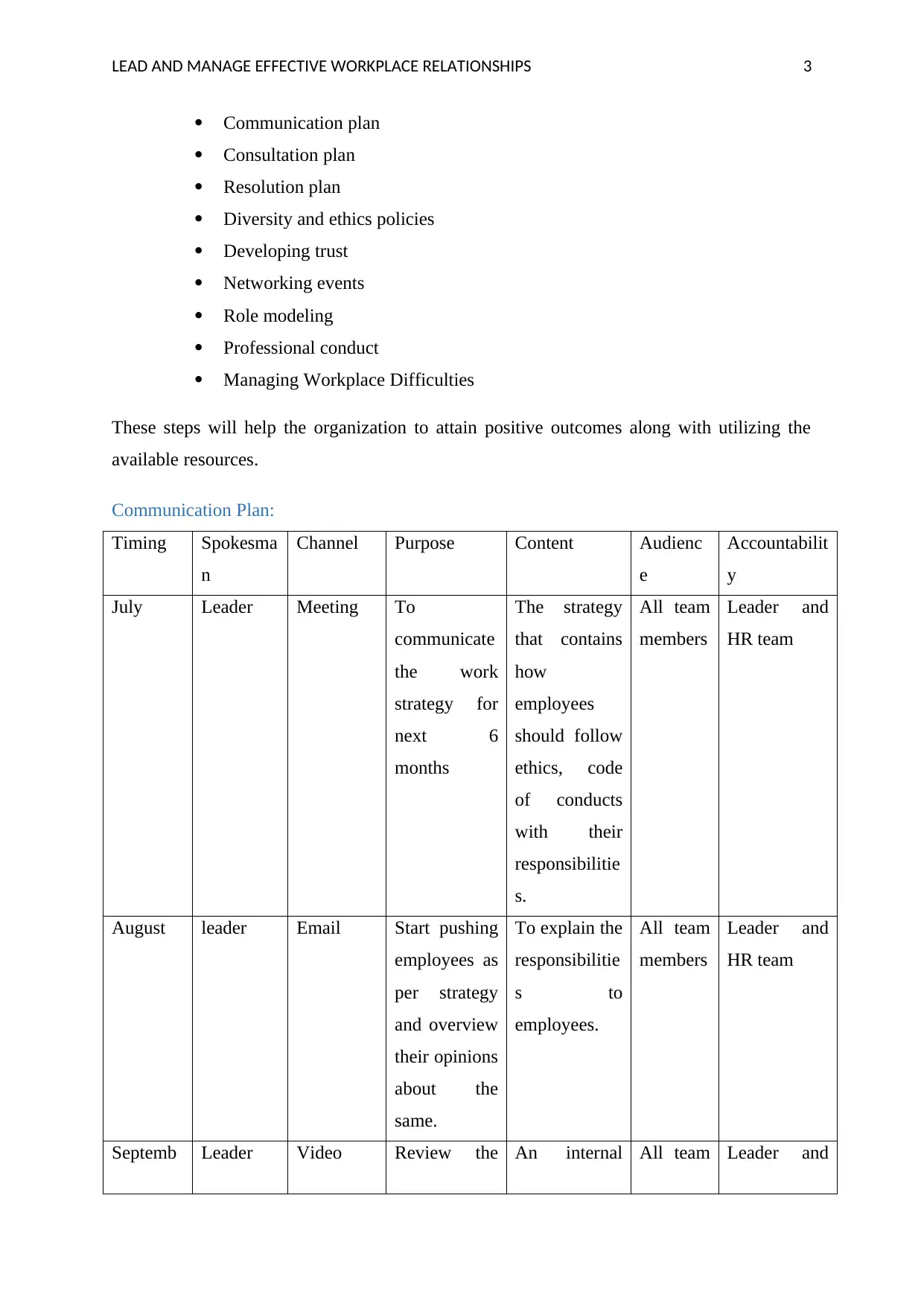
LEAD AND MANAGE EFFECTIVE WORKPLACE RELATIONSHIPS 3
Communication plan
Consultation plan
Resolution plan
Diversity and ethics policies
Developing trust
Networking events
Role modeling
Professional conduct
Managing Workplace Difficulties
These steps will help the organization to attain positive outcomes along with utilizing the
available resources.
Communication Plan:
Timing Spokesma
n
Channel Purpose Content Audienc
e
Accountabilit
y
July Leader Meeting To
communicate
the work
strategy for
next 6
months
The strategy
that contains
how
employees
should follow
ethics, code
of conducts
with their
responsibilitie
s.
All team
members
Leader and
HR team
August leader Email Start pushing
employees as
per strategy
and overview
their opinions
about the
same.
To explain the
responsibilitie
s to
employees.
All team
members
Leader and
HR team
Septemb Leader Video Review the An internal All team Leader and
Communication plan
Consultation plan
Resolution plan
Diversity and ethics policies
Developing trust
Networking events
Role modeling
Professional conduct
Managing Workplace Difficulties
These steps will help the organization to attain positive outcomes along with utilizing the
available resources.
Communication Plan:
Timing Spokesma
n
Channel Purpose Content Audienc
e
Accountabilit
y
July Leader Meeting To
communicate
the work
strategy for
next 6
months
The strategy
that contains
how
employees
should follow
ethics, code
of conducts
with their
responsibilitie
s.
All team
members
Leader and
HR team
August leader Email Start pushing
employees as
per strategy
and overview
their opinions
about the
same.
To explain the
responsibilitie
s to
employees.
All team
members
Leader and
HR team
Septemb Leader Video Review the An internal All team Leader and
Paraphrase This Document
Need a fresh take? Get an instant paraphrase of this document with our AI Paraphraser
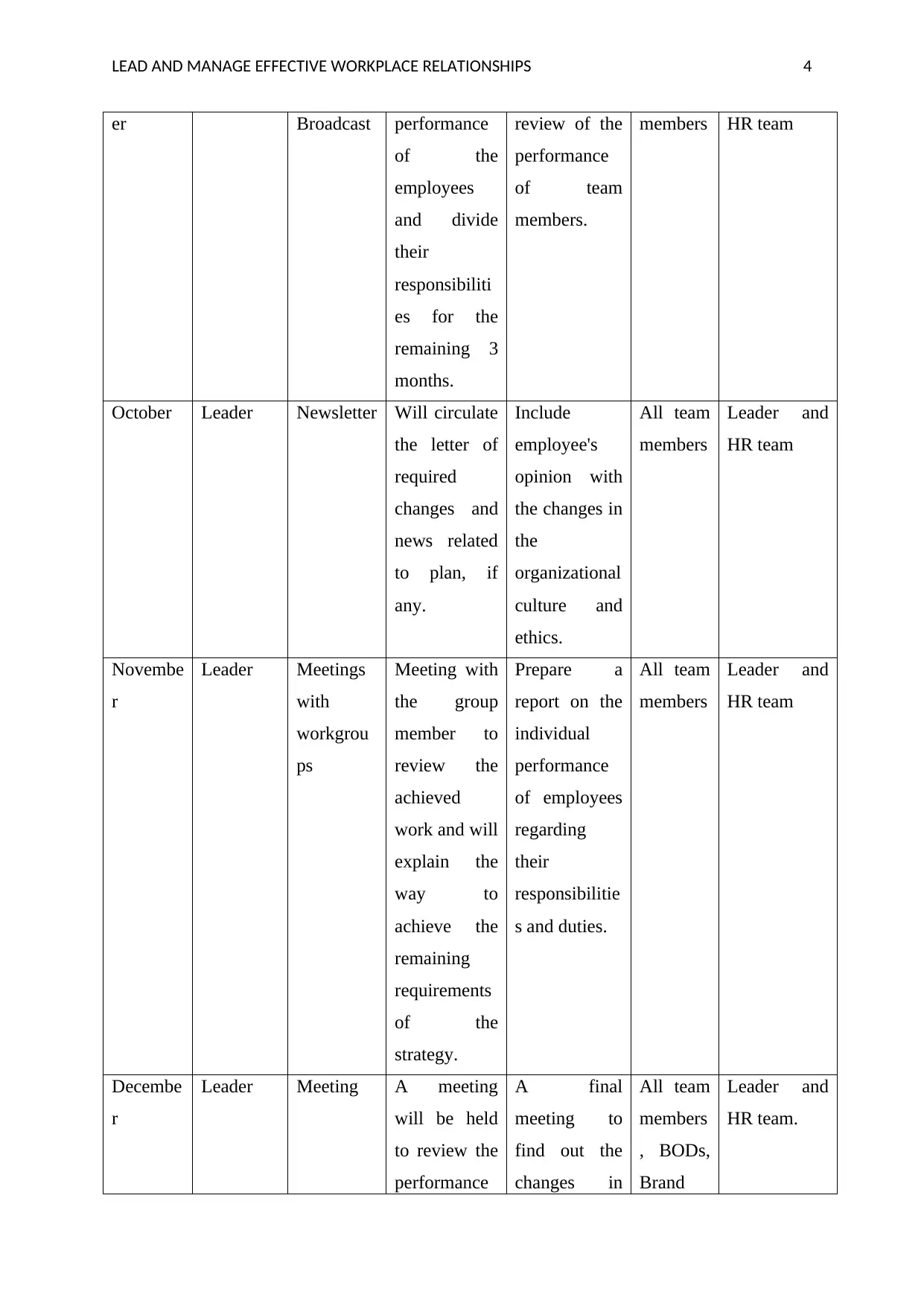
LEAD AND MANAGE EFFECTIVE WORKPLACE RELATIONSHIPS 4
er Broadcast performance
of the
employees
and divide
their
responsibiliti
es for the
remaining 3
months.
review of the
performance
of team
members.
members HR team
October Leader Newsletter Will circulate
the letter of
required
changes and
news related
to plan, if
any.
Include
employee's
opinion with
the changes in
the
organizational
culture and
ethics.
All team
members
Leader and
HR team
Novembe
r
Leader Meetings
with
workgrou
ps
Meeting with
the group
member to
review the
achieved
work and will
explain the
way to
achieve the
remaining
requirements
of the
strategy.
Prepare a
report on the
individual
performance
of employees
regarding
their
responsibilitie
s and duties.
All team
members
Leader and
HR team
Decembe
r
Leader Meeting A meeting
will be held
to review the
performance
A final
meeting to
find out the
changes in
All team
members
, BODs,
Brand
Leader and
HR team.
er Broadcast performance
of the
employees
and divide
their
responsibiliti
es for the
remaining 3
months.
review of the
performance
of team
members.
members HR team
October Leader Newsletter Will circulate
the letter of
required
changes and
news related
to plan, if
any.
Include
employee's
opinion with
the changes in
the
organizational
culture and
ethics.
All team
members
Leader and
HR team
Novembe
r
Leader Meetings
with
workgrou
ps
Meeting with
the group
member to
review the
achieved
work and will
explain the
way to
achieve the
remaining
requirements
of the
strategy.
Prepare a
report on the
individual
performance
of employees
regarding
their
responsibilitie
s and duties.
All team
members
Leader and
HR team
Decembe
r
Leader Meeting A meeting
will be held
to review the
performance
A final
meeting to
find out the
changes in
All team
members
, BODs,
Brand
Leader and
HR team.
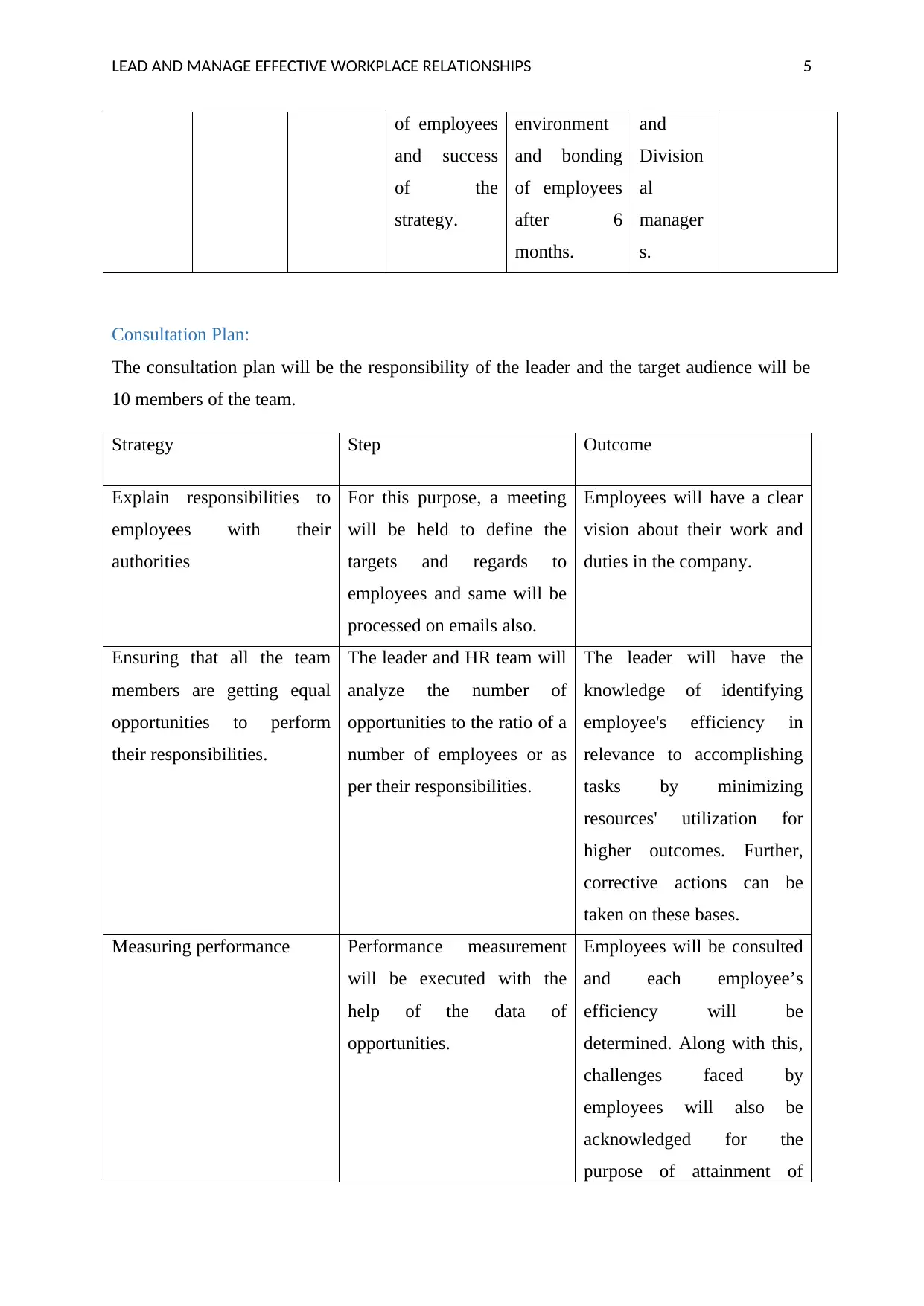
LEAD AND MANAGE EFFECTIVE WORKPLACE RELATIONSHIPS 5
of employees
and success
of the
strategy.
environment
and bonding
of employees
after 6
months.
and
Division
al
manager
s.
Consultation Plan:
The consultation plan will be the responsibility of the leader and the target audience will be
10 members of the team.
Strategy Step Outcome
Explain responsibilities to
employees with their
authorities
For this purpose, a meeting
will be held to define the
targets and regards to
employees and same will be
processed on emails also.
Employees will have a clear
vision about their work and
duties in the company.
Ensuring that all the team
members are getting equal
opportunities to perform
their responsibilities.
The leader and HR team will
analyze the number of
opportunities to the ratio of a
number of employees or as
per their responsibilities.
The leader will have the
knowledge of identifying
employee's efficiency in
relevance to accomplishing
tasks by minimizing
resources' utilization for
higher outcomes. Further,
corrective actions can be
taken on these bases.
Measuring performance Performance measurement
will be executed with the
help of the data of
opportunities.
Employees will be consulted
and each employee’s
efficiency will be
determined. Along with this,
challenges faced by
employees will also be
acknowledged for the
purpose of attainment of
of employees
and success
of the
strategy.
environment
and bonding
of employees
after 6
months.
and
Division
al
manager
s.
Consultation Plan:
The consultation plan will be the responsibility of the leader and the target audience will be
10 members of the team.
Strategy Step Outcome
Explain responsibilities to
employees with their
authorities
For this purpose, a meeting
will be held to define the
targets and regards to
employees and same will be
processed on emails also.
Employees will have a clear
vision about their work and
duties in the company.
Ensuring that all the team
members are getting equal
opportunities to perform
their responsibilities.
The leader and HR team will
analyze the number of
opportunities to the ratio of a
number of employees or as
per their responsibilities.
The leader will have the
knowledge of identifying
employee's efficiency in
relevance to accomplishing
tasks by minimizing
resources' utilization for
higher outcomes. Further,
corrective actions can be
taken on these bases.
Measuring performance Performance measurement
will be executed with the
help of the data of
opportunities.
Employees will be consulted
and each employee’s
efficiency will be
determined. Along with this,
challenges faced by
employees will also be
acknowledged for the
purpose of attainment of
⊘ This is a preview!⊘
Do you want full access?
Subscribe today to unlock all pages.

Trusted by 1+ million students worldwide

LEAD AND MANAGE EFFECTIVE WORKPLACE RELATIONSHIPS 6
desired goals and objectives.
(Lando, 2014)
Resolution Plan:
Specific
Conflict
Find out the issues and specific reason for the particular issue. All sources
and reasons behind the issue will be identified.
Employees
involved
Employees and people involved in the conflict and the root cause of the issue
will be identified. Role of employees will also be determined in the
occurrence of an issue.
Action Plan The leader will try to resolve the conflict by communicating with employees
involves in the conflicts. The opinions of the employees will also be
considered and examined to obtain results through which appropriate
decision could be taken.
Expected
Results
Expected results will include the solution of the conflicts and satisfaction of
the employees affected. The ethics of the company and responsibilities for
the same will be considered at the time of making the decision.
Accountable Leaders, HR department, Line managers, and legal department (in case of
any legal dispute) will be accountable and responsible for successful
execution of the plan.
(LI et al, 2009), (Longfield et al, 2008)
desired goals and objectives.
(Lando, 2014)
Resolution Plan:
Specific
Conflict
Find out the issues and specific reason for the particular issue. All sources
and reasons behind the issue will be identified.
Employees
involved
Employees and people involved in the conflict and the root cause of the issue
will be identified. Role of employees will also be determined in the
occurrence of an issue.
Action Plan The leader will try to resolve the conflict by communicating with employees
involves in the conflicts. The opinions of the employees will also be
considered and examined to obtain results through which appropriate
decision could be taken.
Expected
Results
Expected results will include the solution of the conflicts and satisfaction of
the employees affected. The ethics of the company and responsibilities for
the same will be considered at the time of making the decision.
Accountable Leaders, HR department, Line managers, and legal department (in case of
any legal dispute) will be accountable and responsible for successful
execution of the plan.
(LI et al, 2009), (Longfield et al, 2008)
Paraphrase This Document
Need a fresh take? Get an instant paraphrase of this document with our AI Paraphraser
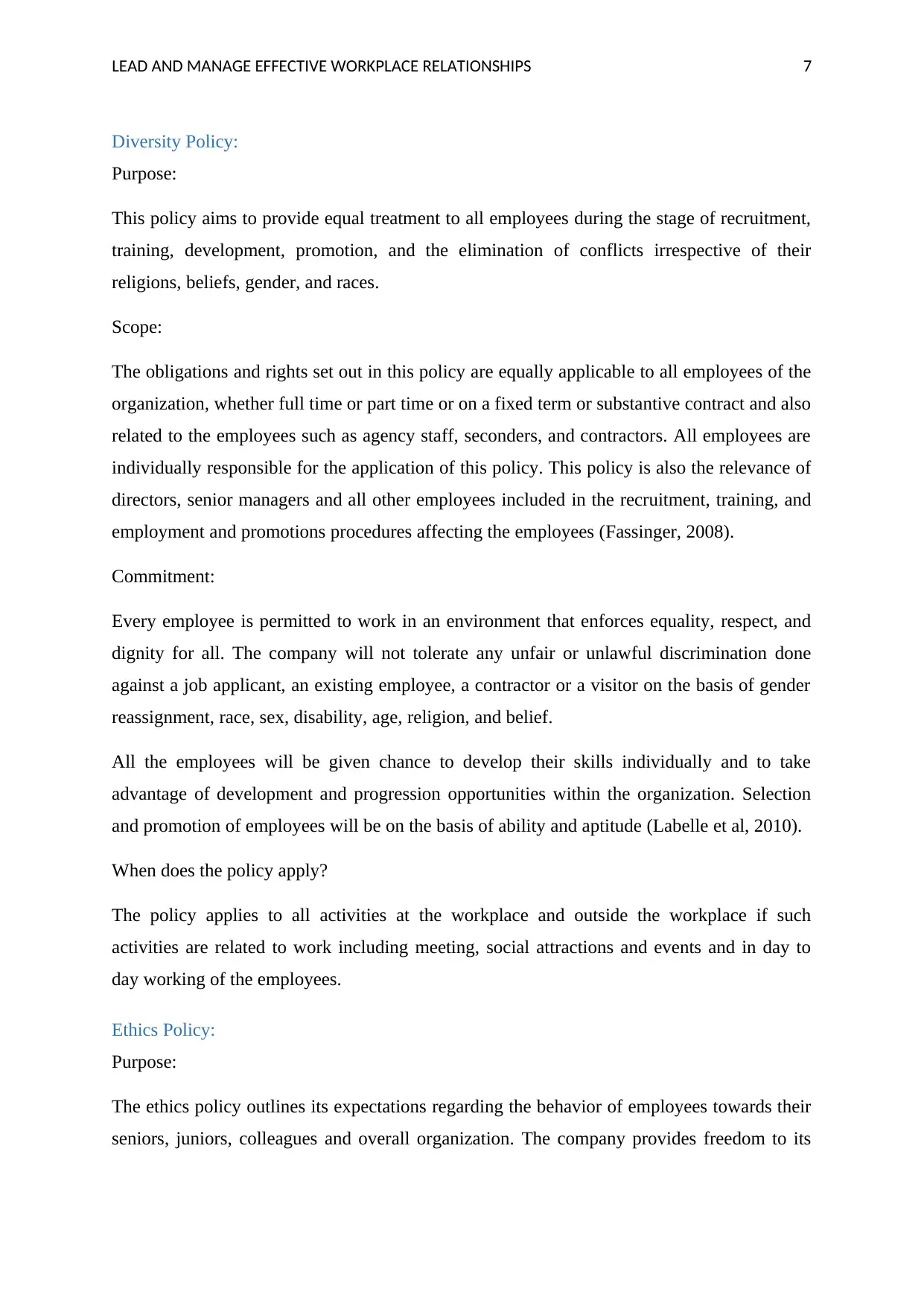
LEAD AND MANAGE EFFECTIVE WORKPLACE RELATIONSHIPS 7
Diversity Policy:
Purpose:
This policy aims to provide equal treatment to all employees during the stage of recruitment,
training, development, promotion, and the elimination of conflicts irrespective of their
religions, beliefs, gender, and races.
Scope:
The obligations and rights set out in this policy are equally applicable to all employees of the
organization, whether full time or part time or on a fixed term or substantive contract and also
related to the employees such as agency staff, seconders, and contractors. All employees are
individually responsible for the application of this policy. This policy is also the relevance of
directors, senior managers and all other employees included in the recruitment, training, and
employment and promotions procedures affecting the employees (Fassinger, 2008).
Commitment:
Every employee is permitted to work in an environment that enforces equality, respect, and
dignity for all. The company will not tolerate any unfair or unlawful discrimination done
against a job applicant, an existing employee, a contractor or a visitor on the basis of gender
reassignment, race, sex, disability, age, religion, and belief.
All the employees will be given chance to develop their skills individually and to take
advantage of development and progression opportunities within the organization. Selection
and promotion of employees will be on the basis of ability and aptitude (Labelle et al, 2010).
When does the policy apply?
The policy applies to all activities at the workplace and outside the workplace if such
activities are related to work including meeting, social attractions and events and in day to
day working of the employees.
Ethics Policy:
Purpose:
The ethics policy outlines its expectations regarding the behavior of employees towards their
seniors, juniors, colleagues and overall organization. The company provides freedom to its
Diversity Policy:
Purpose:
This policy aims to provide equal treatment to all employees during the stage of recruitment,
training, development, promotion, and the elimination of conflicts irrespective of their
religions, beliefs, gender, and races.
Scope:
The obligations and rights set out in this policy are equally applicable to all employees of the
organization, whether full time or part time or on a fixed term or substantive contract and also
related to the employees such as agency staff, seconders, and contractors. All employees are
individually responsible for the application of this policy. This policy is also the relevance of
directors, senior managers and all other employees included in the recruitment, training, and
employment and promotions procedures affecting the employees (Fassinger, 2008).
Commitment:
Every employee is permitted to work in an environment that enforces equality, respect, and
dignity for all. The company will not tolerate any unfair or unlawful discrimination done
against a job applicant, an existing employee, a contractor or a visitor on the basis of gender
reassignment, race, sex, disability, age, religion, and belief.
All the employees will be given chance to develop their skills individually and to take
advantage of development and progression opportunities within the organization. Selection
and promotion of employees will be on the basis of ability and aptitude (Labelle et al, 2010).
When does the policy apply?
The policy applies to all activities at the workplace and outside the workplace if such
activities are related to work including meeting, social attractions and events and in day to
day working of the employees.
Ethics Policy:
Purpose:
The ethics policy outlines its expectations regarding the behavior of employees towards their
seniors, juniors, colleagues and overall organization. The company provides freedom to its
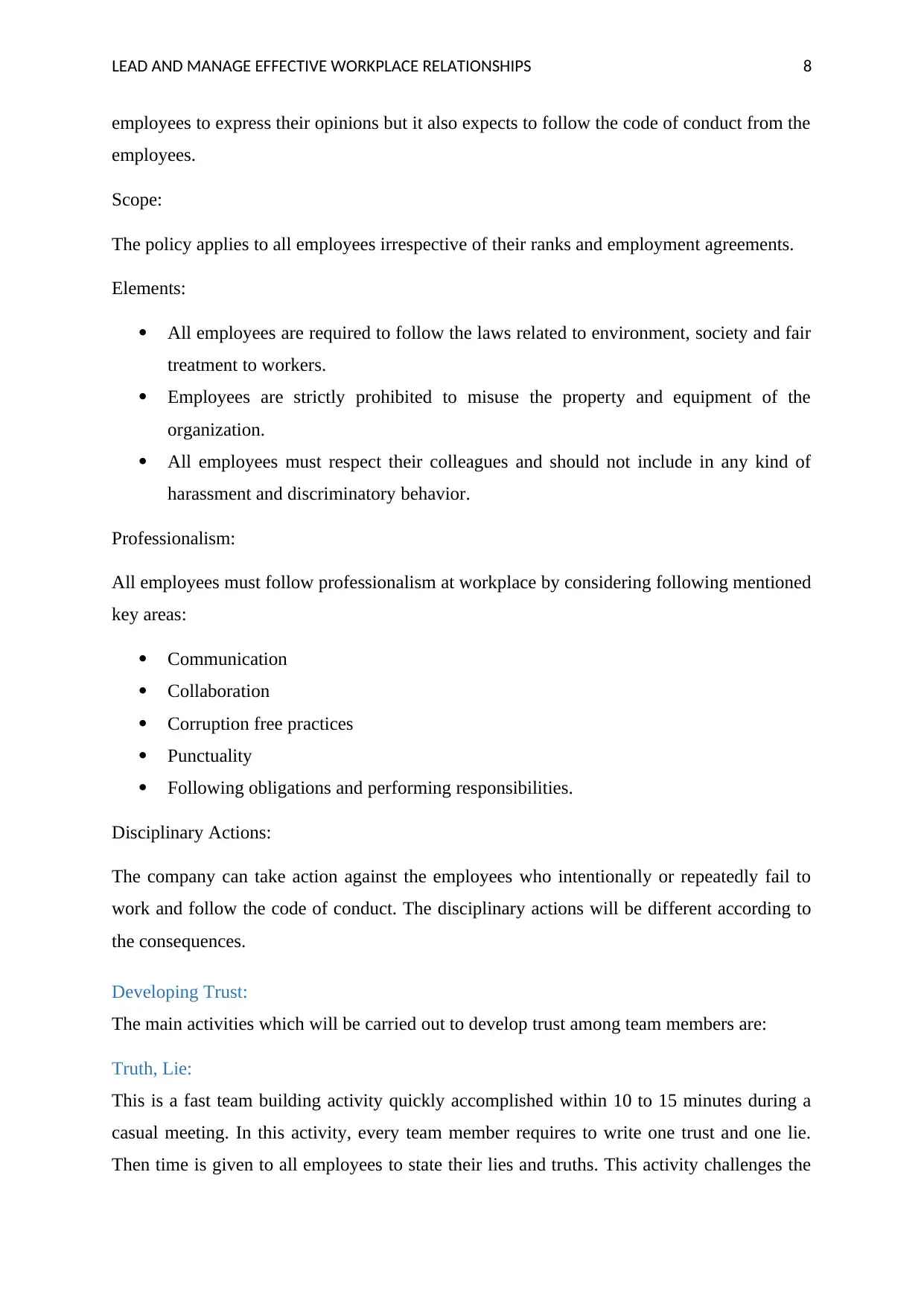
LEAD AND MANAGE EFFECTIVE WORKPLACE RELATIONSHIPS 8
employees to express their opinions but it also expects to follow the code of conduct from the
employees.
Scope:
The policy applies to all employees irrespective of their ranks and employment agreements.
Elements:
All employees are required to follow the laws related to environment, society and fair
treatment to workers.
Employees are strictly prohibited to misuse the property and equipment of the
organization.
All employees must respect their colleagues and should not include in any kind of
harassment and discriminatory behavior.
Professionalism:
All employees must follow professionalism at workplace by considering following mentioned
key areas:
Communication
Collaboration
Corruption free practices
Punctuality
Following obligations and performing responsibilities.
Disciplinary Actions:
The company can take action against the employees who intentionally or repeatedly fail to
work and follow the code of conduct. The disciplinary actions will be different according to
the consequences.
Developing Trust:
The main activities which will be carried out to develop trust among team members are:
Truth, Lie:
This is a fast team building activity quickly accomplished within 10 to 15 minutes during a
casual meeting. In this activity, every team member requires to write one trust and one lie.
Then time is given to all employees to state their lies and truths. This activity challenges the
employees to express their opinions but it also expects to follow the code of conduct from the
employees.
Scope:
The policy applies to all employees irrespective of their ranks and employment agreements.
Elements:
All employees are required to follow the laws related to environment, society and fair
treatment to workers.
Employees are strictly prohibited to misuse the property and equipment of the
organization.
All employees must respect their colleagues and should not include in any kind of
harassment and discriminatory behavior.
Professionalism:
All employees must follow professionalism at workplace by considering following mentioned
key areas:
Communication
Collaboration
Corruption free practices
Punctuality
Following obligations and performing responsibilities.
Disciplinary Actions:
The company can take action against the employees who intentionally or repeatedly fail to
work and follow the code of conduct. The disciplinary actions will be different according to
the consequences.
Developing Trust:
The main activities which will be carried out to develop trust among team members are:
Truth, Lie:
This is a fast team building activity quickly accomplished within 10 to 15 minutes during a
casual meeting. In this activity, every team member requires to write one trust and one lie.
Then time is given to all employees to state their lies and truths. This activity challenges the
⊘ This is a preview!⊘
Do you want full access?
Subscribe today to unlock all pages.

Trusted by 1+ million students worldwide
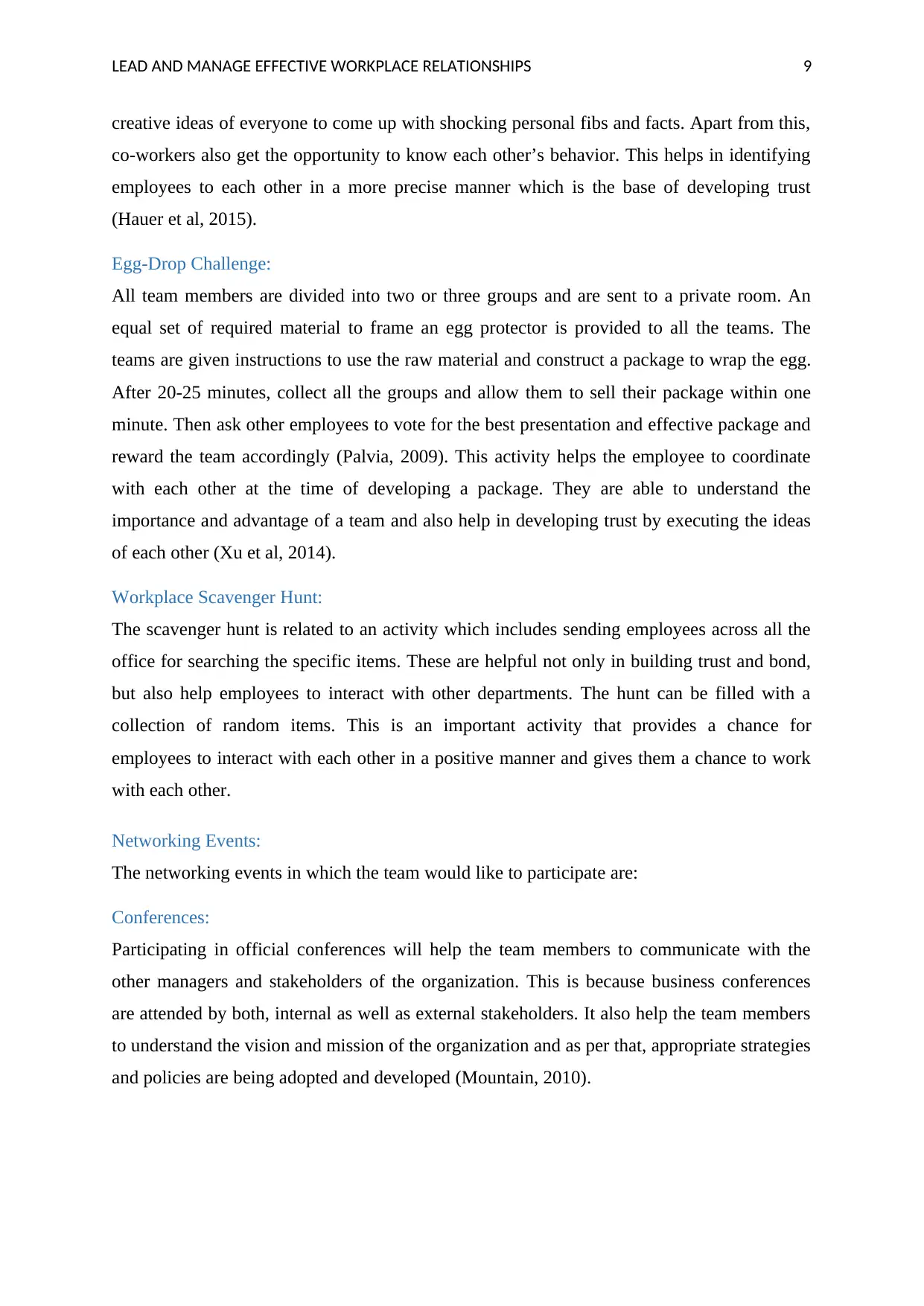
LEAD AND MANAGE EFFECTIVE WORKPLACE RELATIONSHIPS 9
creative ideas of everyone to come up with shocking personal fibs and facts. Apart from this,
co-workers also get the opportunity to know each other’s behavior. This helps in identifying
employees to each other in a more precise manner which is the base of developing trust
(Hauer et al, 2015).
Egg-Drop Challenge:
All team members are divided into two or three groups and are sent to a private room. An
equal set of required material to frame an egg protector is provided to all the teams. The
teams are given instructions to use the raw material and construct a package to wrap the egg.
After 20-25 minutes, collect all the groups and allow them to sell their package within one
minute. Then ask other employees to vote for the best presentation and effective package and
reward the team accordingly (Palvia, 2009). This activity helps the employee to coordinate
with each other at the time of developing a package. They are able to understand the
importance and advantage of a team and also help in developing trust by executing the ideas
of each other (Xu et al, 2014).
Workplace Scavenger Hunt:
The scavenger hunt is related to an activity which includes sending employees across all the
office for searching the specific items. These are helpful not only in building trust and bond,
but also help employees to interact with other departments. The hunt can be filled with a
collection of random items. This is an important activity that provides a chance for
employees to interact with each other in a positive manner and gives them a chance to work
with each other.
Networking Events:
The networking events in which the team would like to participate are:
Conferences:
Participating in official conferences will help the team members to communicate with the
other managers and stakeholders of the organization. This is because business conferences
are attended by both, internal as well as external stakeholders. It also help the team members
to understand the vision and mission of the organization and as per that, appropriate strategies
and policies are being adopted and developed (Mountain, 2010).
creative ideas of everyone to come up with shocking personal fibs and facts. Apart from this,
co-workers also get the opportunity to know each other’s behavior. This helps in identifying
employees to each other in a more precise manner which is the base of developing trust
(Hauer et al, 2015).
Egg-Drop Challenge:
All team members are divided into two or three groups and are sent to a private room. An
equal set of required material to frame an egg protector is provided to all the teams. The
teams are given instructions to use the raw material and construct a package to wrap the egg.
After 20-25 minutes, collect all the groups and allow them to sell their package within one
minute. Then ask other employees to vote for the best presentation and effective package and
reward the team accordingly (Palvia, 2009). This activity helps the employee to coordinate
with each other at the time of developing a package. They are able to understand the
importance and advantage of a team and also help in developing trust by executing the ideas
of each other (Xu et al, 2014).
Workplace Scavenger Hunt:
The scavenger hunt is related to an activity which includes sending employees across all the
office for searching the specific items. These are helpful not only in building trust and bond,
but also help employees to interact with other departments. The hunt can be filled with a
collection of random items. This is an important activity that provides a chance for
employees to interact with each other in a positive manner and gives them a chance to work
with each other.
Networking Events:
The networking events in which the team would like to participate are:
Conferences:
Participating in official conferences will help the team members to communicate with the
other managers and stakeholders of the organization. This is because business conferences
are attended by both, internal as well as external stakeholders. It also help the team members
to understand the vision and mission of the organization and as per that, appropriate strategies
and policies are being adopted and developed (Mountain, 2010).
Paraphrase This Document
Need a fresh take? Get an instant paraphrase of this document with our AI Paraphraser
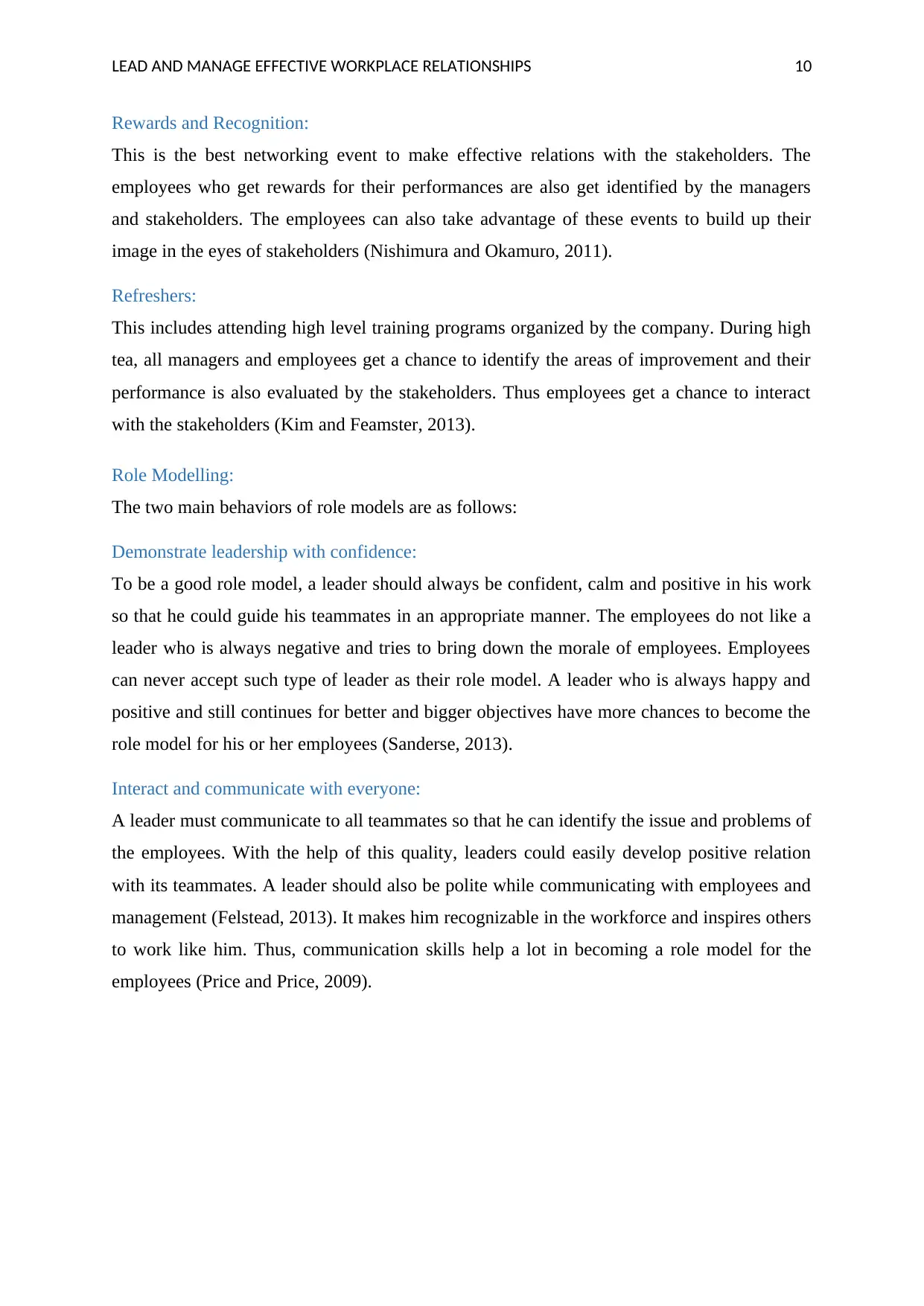
LEAD AND MANAGE EFFECTIVE WORKPLACE RELATIONSHIPS 10
Rewards and Recognition:
This is the best networking event to make effective relations with the stakeholders. The
employees who get rewards for their performances are also get identified by the managers
and stakeholders. The employees can also take advantage of these events to build up their
image in the eyes of stakeholders (Nishimura and Okamuro, 2011).
Refreshers:
This includes attending high level training programs organized by the company. During high
tea, all managers and employees get a chance to identify the areas of improvement and their
performance is also evaluated by the stakeholders. Thus employees get a chance to interact
with the stakeholders (Kim and Feamster, 2013).
Role Modelling:
The two main behaviors of role models are as follows:
Demonstrate leadership with confidence:
To be a good role model, a leader should always be confident, calm and positive in his work
so that he could guide his teammates in an appropriate manner. The employees do not like a
leader who is always negative and tries to bring down the morale of employees. Employees
can never accept such type of leader as their role model. A leader who is always happy and
positive and still continues for better and bigger objectives have more chances to become the
role model for his or her employees (Sanderse, 2013).
Interact and communicate with everyone:
A leader must communicate to all teammates so that he can identify the issue and problems of
the employees. With the help of this quality, leaders could easily develop positive relation
with its teammates. A leader should also be polite while communicating with employees and
management (Felstead, 2013). It makes him recognizable in the workforce and inspires others
to work like him. Thus, communication skills help a lot in becoming a role model for the
employees (Price and Price, 2009).
Rewards and Recognition:
This is the best networking event to make effective relations with the stakeholders. The
employees who get rewards for their performances are also get identified by the managers
and stakeholders. The employees can also take advantage of these events to build up their
image in the eyes of stakeholders (Nishimura and Okamuro, 2011).
Refreshers:
This includes attending high level training programs organized by the company. During high
tea, all managers and employees get a chance to identify the areas of improvement and their
performance is also evaluated by the stakeholders. Thus employees get a chance to interact
with the stakeholders (Kim and Feamster, 2013).
Role Modelling:
The two main behaviors of role models are as follows:
Demonstrate leadership with confidence:
To be a good role model, a leader should always be confident, calm and positive in his work
so that he could guide his teammates in an appropriate manner. The employees do not like a
leader who is always negative and tries to bring down the morale of employees. Employees
can never accept such type of leader as their role model. A leader who is always happy and
positive and still continues for better and bigger objectives have more chances to become the
role model for his or her employees (Sanderse, 2013).
Interact and communicate with everyone:
A leader must communicate to all teammates so that he can identify the issue and problems of
the employees. With the help of this quality, leaders could easily develop positive relation
with its teammates. A leader should also be polite while communicating with employees and
management (Felstead, 2013). It makes him recognizable in the workforce and inspires others
to work like him. Thus, communication skills help a lot in becoming a role model for the
employees (Price and Price, 2009).
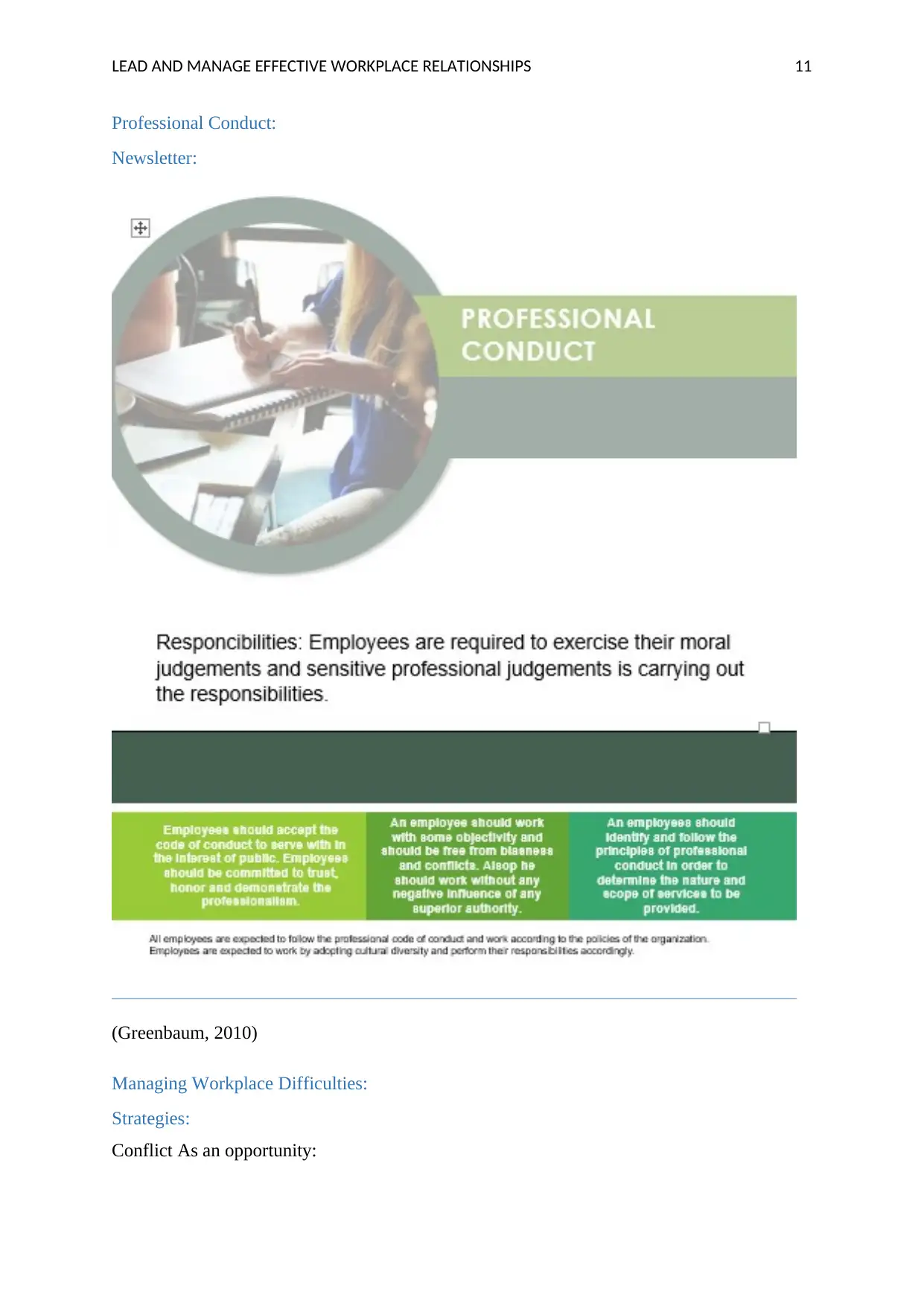
LEAD AND MANAGE EFFECTIVE WORKPLACE RELATIONSHIPS 11
Professional Conduct:
Newsletter:
(Greenbaum, 2010)
Managing Workplace Difficulties:
Strategies:
Conflict As an opportunity:
Professional Conduct:
Newsletter:
(Greenbaum, 2010)
Managing Workplace Difficulties:
Strategies:
Conflict As an opportunity:
⊘ This is a preview!⊘
Do you want full access?
Subscribe today to unlock all pages.

Trusted by 1+ million students worldwide
1 out of 17
Related Documents
Your All-in-One AI-Powered Toolkit for Academic Success.
+13062052269
info@desklib.com
Available 24*7 on WhatsApp / Email
![[object Object]](/_next/static/media/star-bottom.7253800d.svg)
Unlock your academic potential
Copyright © 2020–2025 A2Z Services. All Rights Reserved. Developed and managed by ZUCOL.




